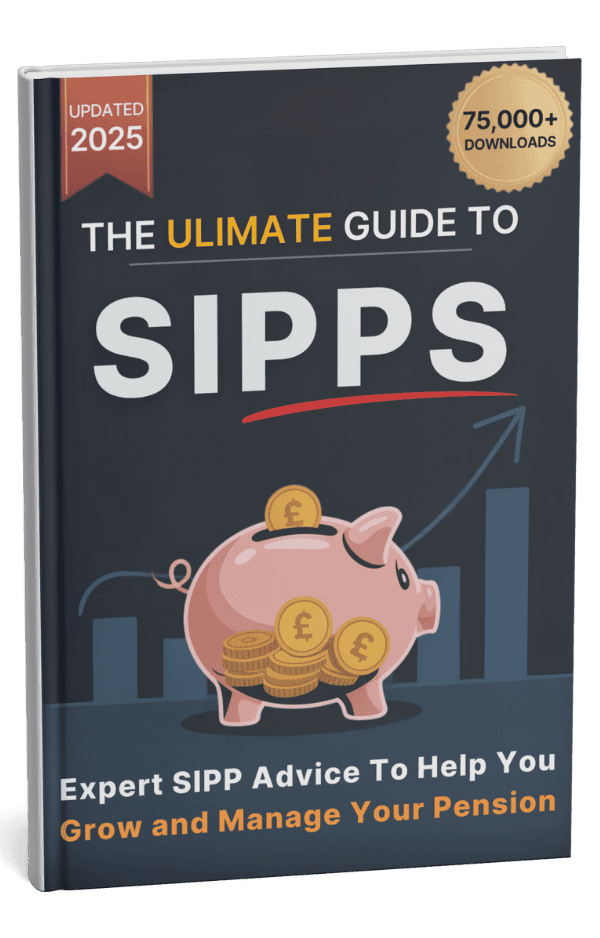
SIPPs and Taxes: 4 Key Tax Implications to Know About in 2025
See How Much Your Future Pension Income Could Be In Just 60 Seconds — No Fees, No Obligation.
How Much Could You Unlock?
Why Homeowners Trust Us
Try Our Free Pension Calculator
Quick, Safe Estimate

No Commitments
Key Takeaways
- SIPPs offer tax relief on contributions, with higher- and additional-rate taxpayers able to claim extra through self-assessment.
- Investment growth within a SIPP is untaxed, helping maximise returns over the long term.
- You can withdraw 25% of your SIPP without paying tax, with the remainder taxed as income based on your marginal rate.
- SIPPs can be passed on free of inheritance tax if the holder dies before age 75, though rules may change from 2027.
SIPPs and taxes are inextricably linked when it comes to planning a financially secure retirement.
According to HMRC statistics quoted in Pensions Age, pensions tax relief is estimated to have amounted to £52 billion in 2023/24.1
These figures underline the importance of grasping how taxes may apply to your SIPP.
The relationship between your Self-Invested Personal Pension (SIPP) and taxes influences everything from the contributions you make to the capital gains you may earn and the withdrawals you'll eventually make.
In this article, we aim to demystify the subject, shedding light on how tax considerations can affect the performance and benefits of your SIPP.
Whether you are well-versed in the world of investments or taking your first steps towards retirement planning, understanding the tax aspects of your pension will be extremely important if you’re trying to make the most of your retirement funds.
In This Article, You Will Discover:
The EveryInvestor team is here to provide reliable and trusted information on SIPPs and taxes, helping you make informed decisions regarding your financial future.
All our articles undergo thorough fact-checking before publication so you can rest assured you’re receiving relevant, up-to-date information.
Let’s get straight to it.
What Is a SIPP?
A SIPP is a Self-Invested Personal Pension, a type of UK pension that offers individuals greater control over their retirement savings.
Unlike traditional pensions, a SIPP allows you to manage and choose your own investments, including stocks, funds, and commercial property.
SIPPs enable account-holders to have greater control over their pension funds and make investment decisions aligned with their financial goals and risk tolerance.
Why Are Tax Considerations Important When It Comes to SIPPs?
Tax considerations are important when it comes to SIPPs because they directly impact how efficiently you can grow and withdraw your retirement savings.
Understanding tax rules allows you to maximise benefits such as tax relief on contributions, tax-free investment growth, and inheritance tax advantages.
It also helps you avoid unexpected tax charges, such as those from exceeding the annual allowance or mismanaging withdrawals, which could lead to higher income tax liabilities.
By planning carefully, you can optimise your pension strategy, minimise tax burdens, and ensure a more secure financial future.
Let's take a look at the SIPPs tax considerations you need to be aware of.

Tax Benefits of SIPP Contributions
The tax benefits of SIPP contributions make them an attractive option for retirement planning in the UK.
Contributions to a Self-Invested Personal Pension (SIPP) qualify for tax relief at your marginal rate, meaning basic rate taxpayers receive 20% relief, while higher and additional rate taxpayers can claim 40% or 45% through self-assessment.2
This effectively boosts the value of your pension pot, allowing for more substantial long-term growth.
Basic-Rate Relief
If you are a basic-rate taxpayer, pensions tax relief essentially means that every £80 you contribute to your pension will be topped up by £20 by the government to bring your contribution to £100.
This relief is automatically added to your pension, so you do not need to do anything to claim it.3
Higher-Rate Relief
In our £80 contribution scenario, the same applies if you are a higher-rate taxpayer, but you'll also be able to claim a further £20 when doing your self-assessment.
In other words, you'll end up with a £40 tax saving, and will only need to pay £60 to reach a £100 contribution.
Additional-Rate Relief
If you are an additional-rate taxpayer, you'll be able to claim back £25 through your self-assessment (above and beyond the automatic £20 initial tax relief).
This means you'll have paid £55 to reach a £100 contribution.
In short
By strategically managing contributions, individuals can maximise their pension savings while minimising tax liabilities.
As always, tax rules can be complex and subject to change, and the benefits depend on individual circumstances.
It's therefore advisable to seek professional guidance from a qualified pensions or tax advisor.
Tax-Free Growth and Investment Benefits
The tax-free growth and investment benefits of a Self-Invested Personal Pension (SIPP) make it a highly tax-efficient retirement savings vehicle.
SIPPs benefit from tax-free investment growth, meaning any capital gains, dividends, or interest earned within the pension wrapper are not subject to tax.
The annual allowance for contributions is £60,000 per year, and exceeding this limit may result in tax charges.
This tax-free environment enables individuals to maximise their investment returns without the burden of annual tax deductions.
Withdrawals and Tax Implications
The withdrawals and tax implications of a Self-Invested Personal Pension (SIPP) are crucial to understand for effective retirement planning.
You can access your pension savings from age 55 (rising to 57 in 2028), with 25% of your pot available tax-free.
The remaining 75% is taxed as income, meaning withdrawals are subject to income tax at your marginal rate.4
You can choose between flexi-access drawdown, which allows flexible withdrawals while keeping funds invested, or purchasing an annuity, which provides a guaranteed income.
If you withdraw funds before the minimum age, penalties may apply unless you meet specific exemptions, such as severe illness.
Understanding these rules ensures you optimise your pension withdrawals while minimising tax liabilities.
Inheritance Tax (IHT) Implications
The inheritance tax (IHT) implications of a Self-Invested Personal Pension (SIPP) are an important consideration for estate planning.
Inherited SIPPs are taxed differently depending on whether the original holder passed away before or after age 75.5
Currently, SIPPs can be passed on to beneficiaries free from inheritance tax, as they are not typically included in the deceased’s estate.
However, beneficiaries may still face income tax on withdrawals if the original pension holder dies after age 75.
If the holder dies before age 75, withdrawals are usually tax-free.
Recent UK government proposals suggest that from April 2027, unused pension funds may be included in estates for IHT purposes, potentially making them subject to the 40% inheritance tax rate on amounts exceeding the £325,000 nil-rate band.
These changes are still under consultation, so it’s essential to stay informed and seek professional advice to optimise pension inheritance planning.
Common Questions
Tax relief is usually added to SIPP contributions within about six to 11 weeks of your contribution (if you’re receiving Basic Rate Tax Relief).6
Additional tax relief for higher-rate taxpayers will have to be claimed through your tax return.
Your SIPP remains tax efficient until you reach the age of 75.7
Beyond your 75th birthday, you won’t receive any tax benefits on your contributions.
Yes, you can access SIPP tax relief of 20% on contributions up to £3,600 if you’re not a taxpayer.8
SIPPs aren’t entirely tax free, but they offer significant tax advantages.
This includes tax relief on contributions, tax-free investment growth, and a tax-free lump sum at retirement.
Tax relief on SIPP contributions is granted at your marginal rate.
Basic rate tax relief is added automatically, while additional relief for higher-rate and additional-rate taxpayers must be claimed from HMRC.
Yes, you can generally transfer your existing pension into a SIPP without tax consequences, but there may be exit charges from your current provider.9
Yes, there are restrictions on SIPP withdrawals such as only being able to take money from your SIPP from age 55 (57 from 2028).
Your SIPP will be passed to your beneficiaries tax free if you die before age 75.
After age 75, your SIPP will typically be subject to income tax at your beneficiaries’ marginal rate.
Yes, tax is payable on SIPP withdrawals in retirement according to your income tax band on any withdrawals after taking your initial tax-free lump sum.
While SIPPs offer certain tax advantages, it’s important to note that you cannot entirely avoid taxes in retirement with SIPPs. Withdrawals from your SIPP are subject to income tax, just like any other source of income.
However, by carefully planning your withdrawals and making use of tax-efficient strategies, you may be able to reduce your tax bill in retirement. Strategies can include spreading out your withdrawals over multiple tax years or taking advantage of tax allowances and reliefs available to retirees.
Seek guidance from a financial advisor to explore strategies that can help minimise your tax liabilities.
SIPPs can potentially reduce your tax bill after the age of 65 by providing flexibility in managing your retirement income. By carefully planning your withdrawals from your SIPP, you can potentially control your taxable income and take advantage of tax allowances and reliefs available to seniors.
For example, you could withdraw smaller amounts each year to stay within a lower tax bracket or make use of the personal allowance to reduce your taxable income. Working with a financial advisor can help you develop a tax-efficient withdrawal strategy tailored to your specific circumstances.
SIPP Taxation in Short
Navigating SIPPs and taxes can be complex, and the rules can change, so it's always wise to seek advice tailored to your circumstances.
The tax advantages associated with SIPPs, including tax relief on contributions, tax-free growth, and the ability to take a portion as a tax-free lump sum at retirement, can significantly boost your pension pot.
However, it's crucial to be aware of the potential tax implications when withdrawing from your SIPP or passing on your pension wealth.
Therefore, staying informed about the intricacies of SIPPs and tax is key to making well-informed decisions and continually learning how to maximise your retirement wealth.

Found an Error? Please report it here.






 100% private. No pressure. Just friendly guidance.
100% private. No pressure. Just friendly guidance.


